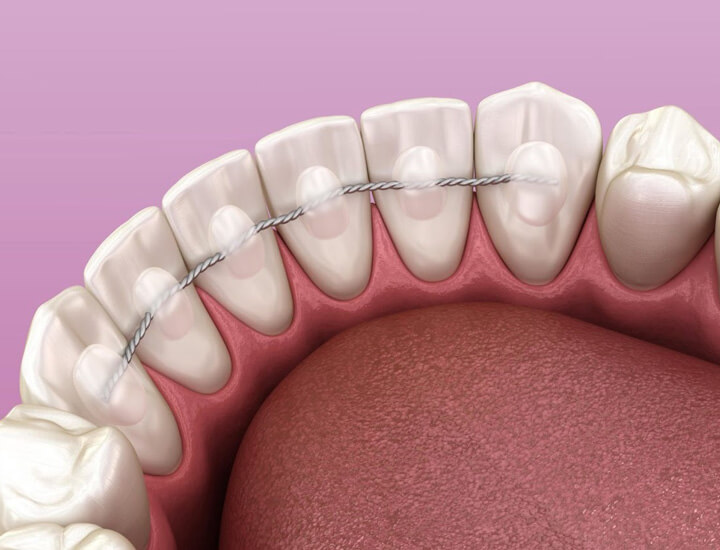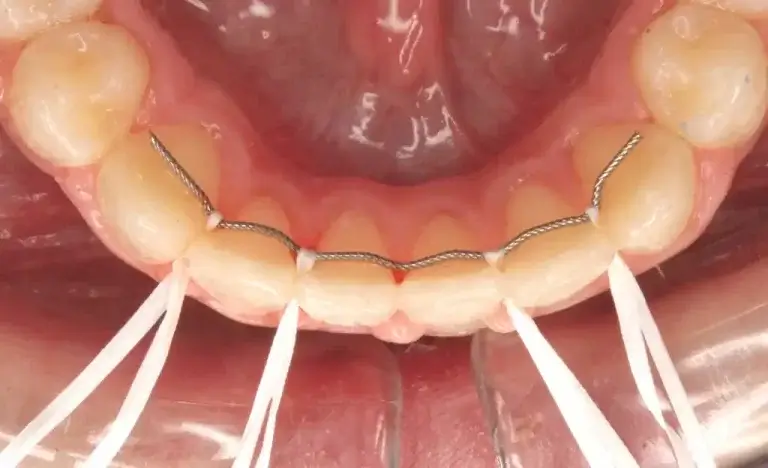Loose Permanent Retainer

What Is A Loose Permanent Retainer?
A permanent orthodontic retainer, also called a lingual wire or fixed retainer, is a thin wire bonded to the back of your teeth to maintain their alignment after orthodontic treatment. While it’s designed to stay in place indefinitely, it can sometimes become loose due to various factors, such as biting down on hard foods, trauma to the mouth, or normal wear and tear over time. A loose permanent retainer can be uncomfortable and may lead to further dental issues if not promptly addressed. It can can even break or fall off entirely.
Before you contact a Toronto dentist to examine A Loose Permanent Retainer, there are some things you should know as a patient:
- Why Do Permanent Retainers Become Loose?
- Signs And Symptoms Of A Loose Permanent Retainer
- Treatment Options For A Loose Permanent Retainer
- Managing A Loose Permanent Retainer Until You Can See The Dentist
- Frequently Asked Questions About Loose Permanent Retainers
If you have questions about A Loose Permanent Retainer or other dental problems, please contact us for more information.
Why Do Permanent Retainers Become Loose?
Here are common reasons why your permanent retainer might loosen:
- Biting Down on Hard Foods: Foods like nuts, ice, or hard candies can place excessive pressure on the retainer, causing it to loosen.
- Trauma or Injury: A blow to the mouth from sports or an accident can dislodge the retainer.
- Normal Wear and Tear: Over time, the dental cement that bonds the retainer weakens, potentially causing it to detach.
- Poor Oral Hygiene: Accumulated plaque and tartar around the retainer weaken the bond and may lead to gum disease or tooth decay.
It’s important to address a loose permanent retainer as soon as possible, as it can lead to further dental problems if left untreated. If you have further questions about A Loose Permanent Retainer, please contact us.
Signs And Symptoms Of A Loose Permanent Retainer
Be on the lookout for these symptoms:
- Shifting Teeth: A loose retainer can allow your teeth to move out of alignment.
- Changes in Bite: You might notice your upper and lower teeth no longer fit together as they should.
- Discomfort or Pain: The loose wire may irritate your tongue or gums, leading to soreness or cuts.
- Visible Issues: The wire may no longer sit flush against your teeth or move freely.
If you notice any of these signs, consult your dentist or orthodontist immediately. If you have further questions about signs and symptoms of A Loose Permanent Retainer, please contact us.

Treatment Options For A Loose Permanent Retainer
Your dentist or orthodontist can recommend one of the following treatments based on the condition of your retainer:
- Rebonding the Retainer: If the wire is intact and most bonding is still functional, the retainer can be reattached.
- Replacing the Retainer: A new wire and bonding material may be necessary if the retainer is significantly damaged or old.
- Switching to a Removable Retainer: Removable retainers offer easier hygiene maintenance and can be worn only at night.
- Removing the Retainer Completely: For recurrent issues, permanent removal may be considered, followed by alternative options to maintain tooth alignment.
- Trimming the Retainer: If a sharp or loose end is causing irritation, your dentist can trim it for immediate comfort.
It is important to have a loose permanent retainer addressed as soon as possible to avoid further dental problems. If you have further questions about treatment options for A Loose Permanent Retainer, please contact us.
Managing A Loose Permanent Retainer Until You Can See The Dentist
If you can’t see your dentist right away, try these temporary solutions:
- Avoid Hard Foods: Stick to soft foods that don’t stress the retainer.
- Use Orthodontic Wax: Cover any sharp edges to protect your mouth.
- Wear a Spare Removable Retainer: If you have one, this can help maintain tooth position temporarily.
- Take Over-the-Counter Pain Relievers: Medications like ibuprofen or acetaminophen can reduce pain or sensitivity.
These measures provide temporary relief but don’t replace professional dental care. If you have further questions about how to manage A Loose Permanent Retainer, please contact us.
Frequently Asked Questions About Loose Permanent Retainers
- Can a loose permanent retainer damage my teeth?
Yes, if left untreated, a loose retainer can lead to tooth movement, gum irritation, and even tooth decay or gum disease if hygiene is compromised.
- How long does it take to repair a loose retainer?
Repairing or rebonding a retainer is typically a quick procedure, often completed in a single dental visit.
- Is it painful to fix a loose retainer?
No, fixing a retainer is generally painless. If the bonding process involves removing old cement, you might feel mild discomfort, but it’s minimal.
- How much does it cost to replace a permanent retainer?
The cost varies but typically ranges between $150 and $300, depending on whether the retainer is repaired or replaced entirely.
By addressing a loose permanent retainer promptly, you can maintain your beautiful, straight smile and prevent future dental issues. If you’re experiencing issues with your retainer or have additional questions, contact us today for assistance!

